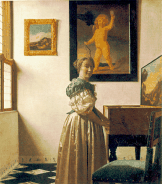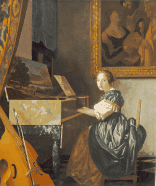 Hpschd
Hpschd

 Hpschd
Hpschd

The Hpschd soundfont is the result of my attempt to give expression to my concept of what a harpsichord should sound like in the context of a PC sound card. The instrument has a long and diverse history; there are many authentic harpsichord sounds. We have reason to believe, in fact, that the historical instruments we now possess are only a feeble remnant of a once proud and vigorous species.
There are two MP3 files hidden on this page that will start to play when you do a "mouse-over". They make perfect sense in the context of where they are hidden. Your success in finding them, however, depends on the whims of your browser and plug-ins. Or, you can look at the HTML source for this page!
Download the Hpschd soundfont (211 KB) here or from the HammerSound site, where you will find it in the "SoundFont Library" filed under "pianos"!
The disposition chosen by Wanda Landowska in her effort to bring the harpsichord back to life after a century's slumber was methodical and purposeful. She had seen and played some of the largest "late model" instruments, particularly those of the Hass family of builders in Hamburg, and sought to combine the tonal resources of these with the convience of registration pedals found on instruments by other builders. The instruments built to her specifications by Pleyel had three sets of strings on the lower manual (16', 8', and 4'). There was a single set of strings on the upper manual (8'), which was equipped with two sets of jacks. One set was very close to the end of the string (the "nut"), resulting in a very dark timbre called "lute stop" in English and"nasat" in some French and German texts; the other set of jacks on the upper manual was farther down the string, producing a more mellow timbre. Each set of strings also had a "buff stop", a set of leather pads that damped the end of the strings, so that the jacks would cause a sort of pizzicato effect. The manuals could be coupled; if the coupler was of the typical sort, the upper manual would remain independently playable while the coupler was engaged. An additional requirement that probably became evident as Landowska's success grew was that the instrument had to be sufficiently robust to withstand being moved around from one concert venue to the next, and eventually, all over the world. Had she not allowed Pleyel to borrow from the technology of the modern piano, it is not likely that her quest to resurrect the harpsichord would have succeeded.
Since this disposition gives the main types of timbre and contrasts that could be expected on the harpsichord, and the maximum amount of flexibility, I have tried to capture these possibilities in a soundfont. After some tinkering, I have come up with a design that seems workable and presents a reasonable approximation of the model. There is even stereo presence, as if you were in the driver's seat. There will be further tinkering, no doubt, and maybe some additional samples. I suggest loading the Hpschd file in bank 40 so that my MIDI realizations can be heard as intended.
| Patch Number | Manual | Description |
|---|---|---|
| I-8 | ||
| I-16 | ||
| I-4 | ||
| II-8 | ||
| II-8 Lute (nasat) | ||
| I-8 Buff | ||
| I-16 Buff | ||
| I-4 Buff | ||
| II-8 Buff | ||
| II-8 Lute Buff | ||
| Plein Jeu I | ||
| I-8 + I-4 | ||
| I-16 + I-4 | ||
| I-8 + I-4 + II-8 | Plein Jeu II | |
| Muselaar | ||
The registration Landowska referred to as "Plein Jeu" could come in two flavors, depending on which of the two sets of jacks of the upper manual was used. Our "Plein Jeu I" uses the II-8 Lute, resulting in a darker, more balanced sound that retains its clarity even in the bass. The "Plein Jeu II" combination, on the other hand, uses the II-8, and has a larger, more open sound that is also more diffuse in the bass.
Many other combinations are possible, and may be obtained copying sections of the MIDI file to additional tracks. Among the more interesting possibilities are combinations of "buff stops" with the II-8 Lute, "gapped" registrations combining I-16 and I-4 (either or both with buff stop), etc. The total number of feasible combinations on an instrument such as this is 134, assuming the manuals are coupled. While not all of these will be particularly distinct or useful, there is obviously enough flexibility for almost any music.
The Muselaar was a characteristic Dutch variation of the small rectangular or oblong instruments collectively called "The Virginals" in English. Those called "Muselaar" had the keyboard shifted toward the right side of the front of the instrument so that the plucking point was near the middle of all the strings, resulting in a harp-like tone. In fact, the Muselaar is acoustically just a small metal-strung harp laid on its side and boxed in. Because of the direction the strings run, as well as the small size of the instrument, there is no stereo presence (low notes at the left, high notes at the right) as there is on the harpsichord. For some pieces, I like to imagine my Muselaar is an even smaller transposing instrument, in F.
On the much-maligned 16' register of the harpsichord, a victim of 20th Century academic fads, please see my essay
"On the Twentieth Century: Where Musicology Went Wrong".
—John W. McCoy
|